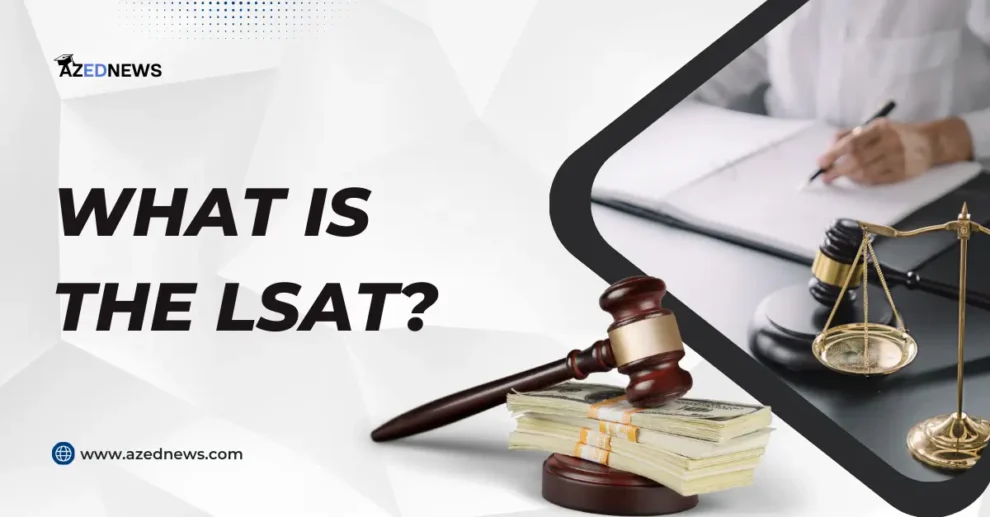The most popular standardized test that law schools require prospective students to take is the LSAT, or Law School Admission Test. What is the LSAT? The LSAT score and writing assignment, along with undergraduate GPA, assist admissions committees in determining an applicant’s likelihood of succeeding in their first year of law school.
Table of Contents
Understand the in-depth details of the LSAT in the blog which includes benefits, tips to prepare, and more.
Key Takeaways:
- The Law School Admission Council administers the written, standardized Law School Admissions Test (LSAT).
- LSAT is an essential exam for students who aspire to build a career in the legal industry.
- The majority of test takers during the previous five years have scored between 150 and 159, proving the exam is difficult to crack.
- Examinees have 35 minutes allotted to them, with a 15-minute intermission following the third section.
- Every year, the LSAT is conducted four times.
- The LSAT application fee is $200 (US dollars). This covers both the actual test and the LSAT writing sample component.
- The various types of questions on the LSAT range from reading comprehension questions, logical reasoning questions and logic game questions, among others.
- Following your LSAT exam, you have six calendar days to cancel your score in your LSAC account.
- The LSAT is one tool used by law school admissions committees to assess applicants’ preparedness for the demands of the legal profession.
What is the LSAT exam?
The Law School Admission Council administers the written, standardized Law School Admissions Test (LSAT). One of the essential prerequisites for applying to law schools in the US, Canada, and several other nations is this.
It is impossible to overstate the significance of the LSAT for aspiring law students. It only takes a few missing points to make the difference between acceptance and rejection.
Note that there are other exams required in addition to the LSAT for admission to law school. You can use the available alternative tests. Taking the LSAT, however, can greatly increase your chances of being admitted to the law school of your dreams since it is unquestionably the most reputable and acknowledged exam.
What are the benefits of LSAT?
LSAT can offer a range of benefits for aspiring lawyers. Some of them are:
- Open-up opportunities: LSAT is the only official and standard test accepted by almost all ABA-approved law schools in the United States.
- Possibility of getting a scholarship: Scoring well in the LSAT can significantly increase the chances of receiving scholarships, which could greatly reduce financial burdens caused by law schools.
- Sets a benchmark: if a student does not score well on the GRE, the LSAT can act as a standardized metric for law schools to compare applicants from various academic backgrounds.
What is the success rate of the LSAT?
The LSAT is unquestionably a difficult test. Nonetheless, the majority of test takers during the previous five years have scored between 150 and 159, according to the Law School Admission Council (LSAC).
Determining the precise level of difficulty on the LSAT is a subjective process that varies from person to person depending on their preparation methods, preparation flaws, and strengths.
The perception of the LSAT’s difficulty is frequently caused by multiple factors:
- Complexity of questions
- Time constraint
- Standardized scoring
However, various law schools don’t require the LSAT. Students can apply to these colleges using their GRE scores, SAT scores, and more.
What are the parts of the LSAT exam?
Students are tested in five important areas on the written LSAT exam. It is over two hours long.
Examinees have 35 minutes allotted to them, with a 15-minute intermission following the third section. There are between 25 and 28 questions in each segment, all of which are multiple-choice.
These are the areas of testing on the LSAT to help you get an idea.
1. Logical reasoning:
The section will consist mostly of brief paragraphs. By utilizing your reasoning skills and locating pertinent facts, you must choose the right response. You’ll use logical reasoning, astute presumptions, and critical thinking and analyzing abilities.
2. Critical Thinking:
The focus of this section is logic games. A scenario with rules and many objectives, e.g., assigning or sorting items, is presented to you. After that, you’ll be required to draw inferences or assumptions in order to determine the right response. These are designed to mimic the same kind of analysis you’ll do later on when working through legal issues.
To choose the right response, you’ll need to apply superior logic and critical thinking to assess certain scenarios. Out of all the LSAT categories, many people believe that the logic game question is the most demanding and tough.
3. Understanding What You Read:
You’ll be required to read and understand lengthy academic sections in this section. To effectively select the right response, you must then infer the text’s logic, organization, and purpose. Additionally, you will be required to compare two books that discuss the same subject in order to find similarities and contrasts between them.
The majority of the subjects addressed are from the social sciences, humanities, and, of course, law. This portion is designed to assess your comprehension of even the longest and most complex text passages—a scenario you’ll frequently encounter in a legal profession.
4. Experimentation and Variability:
An experimental portion makes up the fourth section. This is the only portion of your test that is not assessed, so it has no bearing on your final result. The purpose of this variable section is to test potential future test questions for the LSAT’s developers.
It is impossible to find because it has been nicely incorporated into the other portions. You should only aim to answer each question as best you can; you should be good.
5. Writing sample:
The writing sample is the last section of the LSAT and the only one that is not multiple-choice. Instead, it is formatted like an essay.
You must select one of two options in this area, usually a neutral choice, on the specified issue. Given the information and facts on the subject, you will then need to justify your decision and provide supporting evidence.
It’s crucial to remember that the Writing Sample portion does not have a “right” or “wrong” answer. Rather, the purpose of the test is to evaluate your argumentation skills, which are essential for practicing law.
Where and when can you take the LSAT?
Every year, the LSAT is given four times. As of right now, the dates are set for February, June, September, and December. Tests are administered in October instead of September in certain years. It takes place in testing facilities across the country.
Note that most law schools require you to take the LSATs many months prior to the start of the admissions season, and that there is a limited number of seats available for each LSAT season. Thus, it makes sense to take the LSATs as soon as feasible.
What are the basic LSAT fees?
The LSAT application fee is $200 (US dollars). This covers both the actual test and the LSAT writing sample component. Up to 12 days following the registration deadline, if you try to schedule a test date beyond that time, you will be assessed an extra $100 fee.
If you are unable to take the exam in person at an approved testing center, you can ask LSAC to set up a location close to you. Non-published test Center Fees for this are $295 for US residents and $390 for individuals in other countries.
After you have made your reservation, you can also ask to have the testing center’s date or location changed. Each adjustment (of date or place) costs $125. Keep in mind that requests are only accepted if there are seats available and the deadline for your desired testing location hasn’t already passed.
All LSAT exams are scored by a machine. You can ask for a manual recheck of your scoring if you think there may have been a mistake. Just pay the $100 hand-scoring fee to accomplish this. Any inconsistencies found in the hand scoring will be reflected appropriately in your LSAT scores.
How is the LSAT graded?
Tests other than the LSAT are assessed in a similar manner. Your final grade is calculated using the correct answers. However, the grading system uses three different forms of “scoring” to provide admissions officers with a more accurate picture of your performance.
- The first shows officials how many questions you answered correctly and is called the raw score. A raw score of 80/100, for instance, indicates that you properly answered 80 out of 100 questions. This is how we typically score things.
- The second is called a scaled score, and it is your raw score scaled to fall between 120 and 180. This is necessary because LSATs are normalized, or altered to take into consideration discrepancies and variations in difficulty between administrations.
- Your percentile score comes last. This score compares you to other LSAT takers and indicates how well you performed. A 95% percentile score, for instance, indicates that you are in the top 9% of all LSAT applicants.
A percentile score often provides a better indication of your performance on the LSAT than the raw score does. It also accounts for the overall increase in difficulty over time between test sessions.
Most law schools utilize an index system based on your undergraduate GPA and LSAT scores. The LSAT carries a greater weight in most circumstances, making it more significant than before.
When you give it some thought, this is truly a great thing. You still have a chance to get into law school even if your undergraduate performance was horrible, as long as you score well on the LSAT. This also accounts for those who may not have had a stellar GPA due to inconsistent college experiences.
Components of the LSAT exam:
| LSAT Section | Time | Format |
| Logical Reasoning | 35 mins | 24-26 questions |
| Logic Games | 35 min | 22-24 questions |
| Reading Comprehension | 35 min | 26-28 questions |
| Experimental Section | 35 min | 22-28 questions |
What are the types of questions on the LSAT?
1. LSAT reading comprehension questions:
An LSAT component you are undoubtedly already familiar with from previous standardized tests is reading comprehension, which accounts for about 36% of your final score.
The LSAT measures your comprehension of complex, foreign language writing, but unlike other standardized examinations, it focuses more on understanding the structure, meaning, and multiple points of view of the texts than it does on the facts.
There are four passages on the LSAT, and there are five to eight questions in each. There will be a “paired passage” in one of the passages, and the questions will urge you to compare and contrast the portions. This is the area where preppers typically struggle the most with improvement.
2. LSAT Logical reasoning questions:
About a third of your final score, or logical reasoning, assesses your capacity for argument analysis and evaluation. You must read brief passages on logical reasoning and respond to questions regarding each one.
3. LSAT logic game questions:
31% of your final score is determined by the Logic Games, which assess your knowledge of basic logic, order systems, and outcomes, or, to put it more simply, analytical reasoning. A series of assertions, guidelines, or requirements will be subtracted.
Sets of questions based on a particular passage are presented here. Due to its unfamiliarity, this is the component that many people studying for the LSAT find most daunting at first and frequently the most difficult.
4. LSAT experimental section:
A wild card is the LSAT Experimental Section. It is not scored and will appear precisely like one of the other sections. Its purpose is to help the test creator determine how questions will perform on future LSATs. Put differently, don’t waste exam time attempting to find it.
5. LSAT writing section:
You can finish the 35-minute LSAT essay on-demand whenever it’s most convenient for you. The essay will be accessible starting eight days before your planned LSAT. To get your LSAT score, you have to finish the LSAT writing section. You only need to finish LSAT writing once if you take the test more than once.
What is the duration of the LSAT?
The four portions of the LSAT are each 35 minutes long, with a 10-minute break following the second section. This equals two hours and thirty minutes, or 150 minutes, for the LSAT exam.
The LSAT will be taken on your personal computer at home or at any peaceful location of your choosing. Within each testing window, you will be able to choose from a range of testing times.
In case you lack access to dependable technology, the internet, or a peaceful testing location, the Law School Admission Council (LSAC) can assist you in arranging exceptional accommodations.
Decoding the LSAT score:
The following will be included in your LSAT score when you receive it:
- A “score band” is a range of scaled scores above and below your score, with one overall score that ranges from 120 to 180.
- A percentile score that compares your performance to the results of a sizable sample of other LSAT test takers.
Law schools can be expensive, hence, students can apply to the best companies to refinance law school loans, which can significantly reduce their financial burden.
What is canceling the LSAT score?
Following your LSAT exam, you have six calendar days to cancel your score in your LSAC account. Before you choose to cancel, you won’t be able to view your score. LSAC publishes the average score, each score, and each cancelation if you retake the exam.
The majority of colleges will query several cancellations on your record rather than just one. LSAC also provides a Score Preview option for first-time test takers, allowing them to examine their actual score and choose whether to keep or cancel it.
The service includes a fee, which changes based on when and whether you choose to buy the Score Preview option.
How is the LSAT score used?
Your choice of law school, if you go at all, is largely influenced by your LSAT score. The LSAT is one tool used by law school admissions committees to assess applicants’ preparedness for the demands of the legal profession. It facilitates the comparison of your record with other students’ records by admissions officers.
Law school admissions officers usually cite the LSAT score as the most significant admissions factor, even though law schools use a holistic review process. This is because the test is specifically designed to test your readiness for law school and has a higher correlation to law school success than any other admissions factor.
How to prepare for the LSAT exam?
The LSAT is regarded as one of the hardest tests in the world, yet it’s not insurmountable. Regardless of your prior academic experience, you can actually ace the exam with a little practice.
Experience plays a big part on the LSAT. It is much more important to learn how to answer the questions correctly than to know the hard, unchanging facts because the exam measures your skills rather than your knowledge.
Since the format of the LSAT questions is essentially the same each year, potential applicants can get practice on past years’ surveys.
The LSAC strongly advises that you allow enough time to study for the LSAT. Three months should be the minimal amount of time to practice and prepare; if you want to ace it, give yourself more time.
Frequently Asked Questions:
1. What is the LSAT test needed for?
The LSAT is the only standardized test created especially for admission to law schools. It was created in collaboration with law schools to evaluate the three areas of legal accomplishment that are most important for law school success: reading comprehension, persuasive writing, and critical reasoning.
2. Is the LSAT very different?
Most individuals find the LSAT challenging because it employs novel techniques like logic puzzles and lengthy, wide passages to evaluate abilities that not everyone possesses or utilizes frequently. A solid method to get ready for law school is to prepare for the LSAT.
3. What is a good score on the LSAT?
Experts in law school admissions advise aiming for a minimum score of 150, but for a top-tier law school, you should aim for 160 or above, according to U.S. News. You want a 170 or higher to get into a Top 10 law school.
4. What is the use of your LSAT score?
Even with subpar grades, you might convince yourself that you can handle the demanding coursework of law school with an exceptional LSAT score. On the other hand, if you haven’t attended college in a while, your score may indicate that you still possess the abilities needed to succeed.
5. For how long is the LSAT worth studying?
The amount of time you spend studying for the LSAT is determined by your schedule and goals. It is usually advised by LSAT experts to allocate 150 to 300 hours of study time, which equates to around 12 to 25 hours each week for three months. You should invest the most time if your goal is to get the best score possible.
Conclusion:
The LSAT will test your ability to solve complex problems and will challenge your intellectual limits. But if you accept this challenge and put in the necessary time to prepare well, you can ace the LSAT and get into the law school of your dreams.
Recall that the LSAT is a step toward your future legal career, not just a test. So, make use of all the study tools at your disposal, including online courses, practice exams, and prep books.












Add Comment